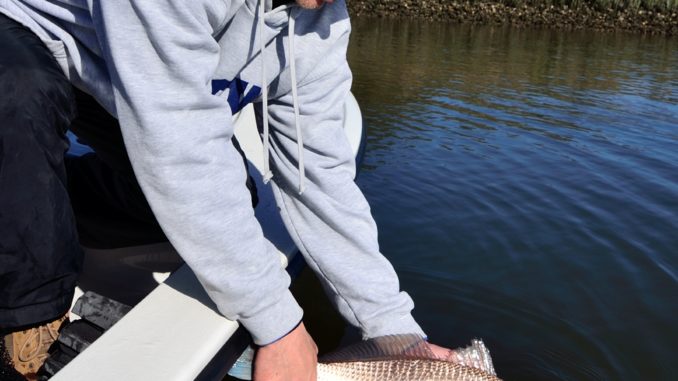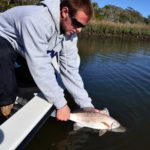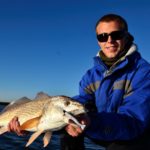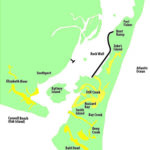
Father-son guide team looks for deep holes in otherwise shallow backwaters for schooling puppy drum.
In North Carolina, February often plagues anglers with bone chilling cold, but the adventurous angler with warm clothes and an appetite for redfish can “endure” double-digit days in in the divine waters of the lower Cape Fear River system.
The winter’s chill revamps daily activities for both predator and prey species in inshore waters. While the giant schools mullet, menhaden and shrimp have been gone since the first major cold fronts of the fall, resident redfish adapt with little effort. They find places in the estuaries with food and protection from marine mammals, and fortunately for anglers, these ideal niches are less common than one would believe, concentrating these fish in large schools.
Capt. Jeffery Wolfe of Seahawk Inshore Fishing Charters specializes in catching redfish in the dead of winter in the lower Cape Fear River. He finds them bunched in small areas in schools as small as 30 to as large as several hundred.
“Cold weather drives reds to places where waters will be slightly warmer than others,” he said. “Water is colder in the high current areas. They tend to tuck into coves with muddy bottoms and little current flow.
Mud-covered bottoms are generally darker in color than lighter-colored sandy bottoms. Sand bottoms reflect the sun, and the darker mud-covered bottoms absorb more of the sun’s radiance, warming the shallow layer of water above.
“Ideally, the best tide is from the mid-fall to the mid-rise,” said Wolfe (910-619-9580), “and low tide during the middle of the day is preferred from 10 a.m. to 2 p.m.”
Redfish and any available baitfish will slide into these areas, taking advantage of the cozy conditions. But many mud flats and remote tidal creeks dry up at low tide, so he looks for and locates creeks that have enough water to fish at the low end of the tide cycle.
“They bunch up in deep holes with some sort of structure on low water,” he said.
Deep spots in the ultra-shallow regions of the marsh are not very common, but they exist in almost every tidal trickle in the region. Often, these deep holes will be isolated throughout the day, with a large portion of the creek or flat leading to the main river left high and dry. They become safe havens for redfish and other winter critters, but the fishing can be phenomenal, even on the coldest days.
Christian Wolfe, who also guides for Seahawk Inshore Fishing Charters, targets these deeper holes in the winter for reds.
“Typically, water depths between four and eight feet at low tide are ideal,” he says. “It depends on the creek, but they will be in the deepest places of the creeks.”
In February, water temperatures can drop to seasonal lows, often reaching the upper 30s during prolonged cold snaps. The deep holes allow the wintering schools to survive until warmer conditions arrive. Any organism capable of locomotion will congregate in these areas, and as the water reaches these seasonable lows, Jeff Wolfe notices that fish will quickly be affected in their winter stance.
“The colder the water, the tighter the schools will be,” he said. “Whether it is warmth in numbers or every fish trying to crowd the slightly warmer spot, they will pack together in cold water.”
Weather affects redfish dramatically at times throughout the season. While Jeff Wolfe expects to catch fish in water as cold as 40 degrees, he prefers targeting them after on days that follow warming trends.
Scented soft plastics are the top choices for lures to tempt winter reds. The Wolfes fish them on smallish jigheads.
“Use the 3-inch Gulp! shrimp primarily, but any kind of scented shrimp imitations are best in the winter,” Christian Wolfe said. “Use 1/8-ounce jig heads if you can, but 1/4-ounce will be necessary in higher wind and current.”
Little action is required from a lure to get these fish to bite in winter. In fact, the scent will entice most fish to bite with little or no movement at all, but Jeff Wolfe prefers to move the lure just enough to get the fish’s attention.
“Twitch the rod tip, barely moving the lure, to give it just a little bit of action,” he said. “I also prefer to use Gulp! Swimming Mullet with the tail action over any of the other types. It gives lots of gentle movement to the bait when pulled very slow.”
When available, natural baits will produce quick results. Live or freshly-cut minnows and shrimp will not last long without a bite when pitched in among reds. These baits should be rigged on light jigheads for the best results. When using natural shrimp and Gulp! baits, anglers can receive a bonus species wearing black and white stripes, as black drum overwinter inshore, also packing into deep pockets in very large schools.
The lower Cape Fear features extensive areas of marsh, with plenty of shallow redfish habitat. The Wolfes concentrate on the waters between Fort Fisher and Bald Head Island, but on occasion, they will cross the river and fish the creeks between Oak Island and the mainland. Luckily, almost every redfish in these waters will be concentrated in isolated pools and coves. Finding these deep-water refuges at low tide can be a problem at low tide, since many will not be accessible. Patrolling creeks on higher tide stages can help locate them; look in creek bends and areas where small creeks converge to find the significant water depth required to hold fish at low tide.
Anglers can expect to get a few shots on higher tides, too, even during the winter. Jeff Wolfe finds these fish in scattered grass and along grass edges close to their low-tide safe havens. Higher water and winter conditions also equates to clearer water, so always keep a lookout for fish cruising or lying motionless along the sea floor.
DESTINATION INFORMATION
HOW TO GET THERE: The waters of the lower Cape Fear River are assessable from numerous points between Snow’s Cut and Southport. On Paradise Island, two main public boat ramps are available: at the end of US 421 at the southern tip of Fort Fisher and at Snow’s Cut. On Oak Island, the Dutchman Creek Park landing a mile east of Southport on NC 133 is available. Southport Marina on West Street in downtown Southport also has boat-launching facilities for a fee.
WHEN TO GO: Winter reds will get in big schools when the water temperature drops into the lower 50s and high 40s. The winter pattern will continue well into March or until the water temperature approaches 60. The best action will be during the middle to the latter part of the day when the sun has warmed waters to their daily peak. The lower tidal sequence is preferred between three hours of the falling tide to the first three hours of the rising tide.
HOT SPOTS: Winter redfish will congregate in creeks, especially in spots out of reach of marine-mammal predators: shallow flats near deep pockets protected by shallow bars are prime areas. The creeks on the east side of the river channel between Bald Head Island Marina and Fort Fisher usually hold the most winter redfish, but shallow areas behind Caswell Beach off the Elizabeth River and off Dutchman’s Creek are known to harbor large schools of redfish in winter.
TACKLE/TECHNIQUES: Both natural bait and artificial lures can be used to tempt redfish in winter. While natural baits can sometimes trigger quicker bites, scented soft-plastic lures, especially imitation shrimp, produce regular strikes when the fish are in a feeding mode. Colors include molting, new penny, natural, and sugar-n-spice. Soft baits should be rigged on either 1/8- or 1/4-ounce jigheads in red, white, black and gray. Baits should be fished very slowly along the bottom with a stop and go retrieve with long pauses between retrieves to get the best results. Medium-heavy, 7-foot spinning outfits are preferred with 14- to 20-pound braid and an 18- to 24-inch fluorocarbon leader.
FISHING INFO/GUIDES: Capt. Jeff Wolfe, Capt. Christian Wolfe, Seahawk Inshore Fishing Charters, 910-619-9580 or www.seahawkinshorefishingcharters.com. See also Guides & Charters in Classifieds.
ACCOMMODATIONS: Brunswick County Vacation Guide, 910-755-5517 or www.ncbrunswick.com; The Official Travel & Tourism Website for North Carolina (www.visitnc.com).
MAPS: Navionics, 800-848-5896, www.navionics.com; The Good Spots, 800-411-0185, www.thegoodspots.com; Grease Charts www.greasechart.com.








Be the first to comment